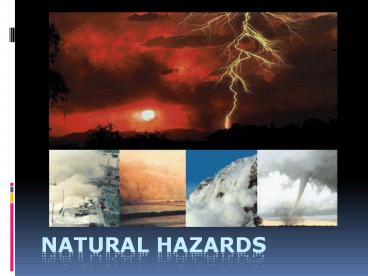Natural Hazards - PowerPoint PPT Presentation
1 / 16
Title:
Natural Hazards
Description:
Natural Hazards? A natural disaster (physical event) volcanic eruption Earthquake Land Human activity Ex: coastal settlement of populations Basically .. – PowerPoint PPT presentation
Number of Views:214
Avg rating:3.0/5.0
Title: Natural Hazards
1
Natural Hazards
2
Natural Hazards?
- A natural disaster (physical event)
- volcanic eruption
- Earthquake
- Landslide
- Human activity
- Ex coastal settlement of populations
3
Basically..
- A natural hazard is
- a naturally occurring
- event/phenomenon
- that has an effect on
- people
4
Vulnerability
- Vulnerability susceptibility to injury or
attack - Human vulnerability leads to financial,
structural, and human losses. - Natural hazards only occur in inhabited areas
- A natural disaster in an uninhabited area has
little tangible impact on people - Natural hazards are increasing because of
- Population growth (more people)
- Urbanization (lots of people in small spaces)
- alteration of the natural environment (manmade
islands)
5
Hazards Human Costs
- Every year natural disasters leave
- 4,000,000 homeless
- 46,000 injured
- 5520 dead
- These figures do not include the recent tsunami
in Asia (273,000) and Hurricane Katrina (1000) - Source The International Red Cross
6
Positive Effects
- natural disasters have beneficial ecological
consequences. - rejuvenation of a coniferous forest months and/or
years after fires - recharging of groundwater stocks after a flood).
- benefits tend to become apparent months or years
after an extreme event
7
Methods of Classification
- Calculating human costs
- Impact measured by
- loss of life (total deaths)
- number of injuries
- damage to property (replacement costs)
8
Methods of Classification
- Strength/size/intensity of event
- Hurricane system
- Tropical depression, tropical storm, category 1-5
- Tornado scale
- Force 1-5
- Richter scale (seismic events)
- Scale of 1-9, with 9 being cataclysmic, worldwide
event - Epidemic, pandemic
9
Methods of Classification
- Regional occurrence
- Hurricane (Atlantic)
- Typhoon (Pacific rim)
- Monsoon (Asia, Africa)
- Frequency of occurrence
- Annually?
- Centenially?
10
Disaster Categories
- We classify natural disasters by the chief
process or sphere in which it operates - Ex Atmosphere, biosphere, lithosphere
- This system has three categories
11
Atmospheric Hazards
- Cyclonic Storms (hurricane, typhoon, cyclone)
- Tornado (twisters, dust devils)
- Severe Storm (White Juan, Noreaster)
- Flooding (heavy rains)
- Drought (lack of rain, prolonged high pressure)
- Wildfire (wind, lightning)
- Severe Weather (hot/cold) ex ice storm
12
Biological Hazards
- Infectious Disease
- HIV, H1N1, Bubonic Plague)
- Parasitic Disease
- ringworm
- Insect Infestation
- malaria, West Nile virus
- Plant Disease
- Dutch Elm disease, blight
13
Geological Hazards
- Slide (mud, land, rock)
- Volcanic Activity
- Earthquake
- Avalanche
- Tsunami (tidal wave)
14
Comparison and Analysis
- Any one disaster can be described by analyzing
various factors that determine how great an
impact it will have on people - This system recognizes six main factors
15
Comparison and Analysis
- Frequency
- how often is the event likely to happen
- Duration
- the length of time the event lasts
- Extent
- Size of area or region affected
- Town? Continent? Region?
16
Comparison and Analysis
- Speed of onset
- sudden, without warning, over quickly?
- build slowly before a peak period
- Spatial dispersion
- area likely to be affected by a particular event
- Temporal spacing
- how hazards and disasters occur in time are they
random or do they occur within a cycle































